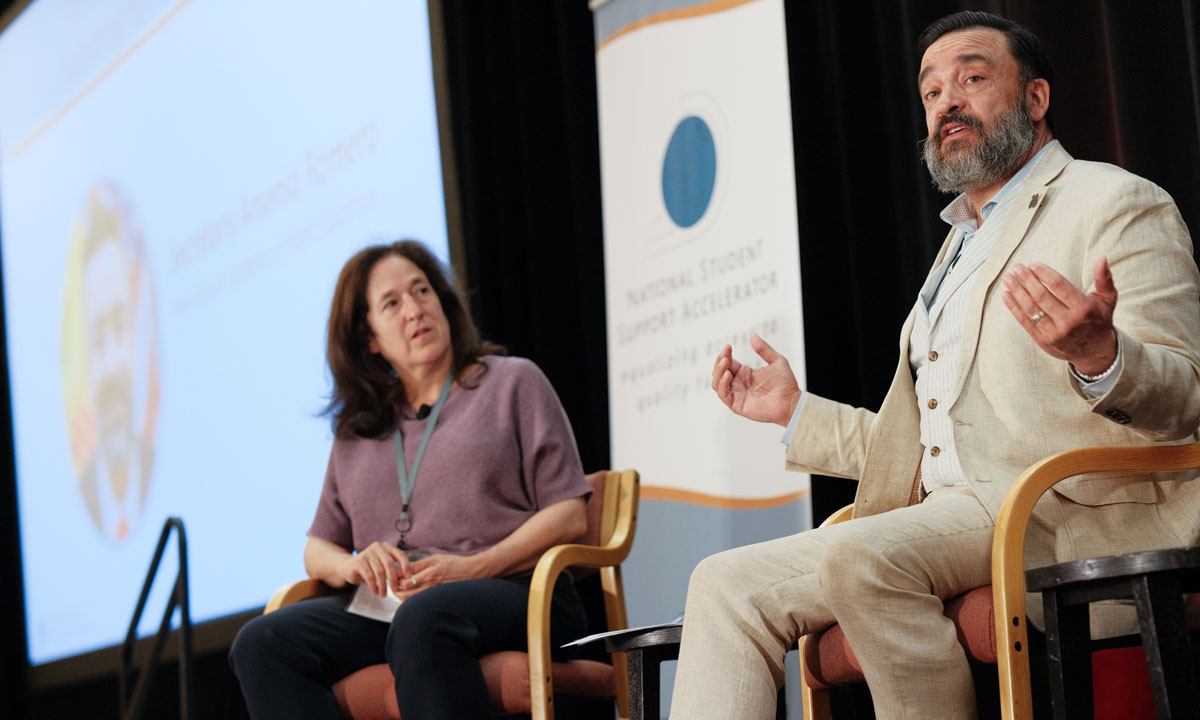Statewide Tutoring Efforts
D.C. Tutoring Program Drives Academic Gains for Black and Low-Income Students
New research from Stanford University has brought a ray of hope for Washington, D.C.’s students, especially Black children and those from low-income families. The research revealed that the city’s substantial investment in a tutoring initiative has borne fruit in its first year, significantly boosting academic performance and narrowing the persistent gaps in reading and math that have disproportionately affected these groups.
With $8.5M Investment, New Mexico Tries Once Again to Get Tutoring Right

New Mexico education Secretary Arsenio Romero discussed tutoring with Stanford University researcher Susanna Loeb at a May conference.
How Districts Can Keep High-Impact Tutoring Going After ESSER Money Expires
Classroom Tech Outpaces Research. Why That’s a Problem
Mays pointed to the move to focus federal pandemic relief money on tutoring programs whose design showed evidence of effectiveness, such as individual or very small groups, and using an aligned curriculum in sessions at least three times a week. This model differed from tutoring provided under the No Child Left Behind Act’s supplemental education services, which were repeatedly found to have no benefit for student achievement—in part because programs varied significantly from district to district.
Resource Provides Guidance on Designing and Implementing Tutoring Programs
The New Jersey Department of Education recently released a resource to provide information on the benefits and essential design elements of effective, high-impact tutoring programs to support local education agencies’ efforts to meet the increased needs of students, according to an advisory.
The resource – “High-Impact Tutoring: An Evidence-Based Strategy to Accelerate Learning” – was developed in response to the strong interest in designing and implementing tutoring programs through both federal and discretionary funding streams. It aims to assist school districts in designing and planning high-impact tutoring programs.
Leadership Is Key, Autonomy Matters: Lessons in Why Tutoring Programs Work
I spent the past year visiting Jackson and eight other schools across three states and the District of Columbia to understand how and why their successful tutoring programs work and the challenges they’ve had to navigate. Our FutureEd study also included dozens of conversations with educators, school district leaders, providers, researchers and others who have turned to tutoring to combat learning loss after COVID.
Is Tutoring at Risk? States Stretch to Keep Funding in Place
When Muriel Bowser, the mayor of the District of Columbia, announced in early March that her administration had carved out $4.8 million for “high impact tutoring” in its 2024-25 budget, she was met with thunderous applause.
Bowser had made the announcement to a room packed with administrators, tutoring service providers and policy analysts. But the excitement was tempered somewhat by questions about how far these funds would go: Is this appropriation enough? What about tutoring in the next year?
As the federal stimulus package—ESSER—winds down, states are racing against the clock to find other sustainable funding sources to keep tutoring alive in their schools. So far, states have taken a patchwork approach. Some states are creating policies that would embed tutoring as a service; other states have relied on one-time grants.
How In-School Tutoring Benefits Both Attendance and Math Scores
Those efforts have helped pay dividends for attendance, too. In the second study, released earlier this month, researchers with Stanford University’s National Student Support Accelerator found that students are 7 percent less likely to be absent on days they have scheduled tutoring sessions. The study, conducted over the 2022-23 school year, examined absenteeism rates of 4,478 students in 141 schools in the District of Columbia.
“There are lots of reasons why students are absent. Being disengaged in school is one reason,” said Nancy Waymack, the director of partnerships and policy at the NSSA."Tutoring is one way that students can have one more meaningful relationship in school. Tutoring can be one tool to move the needle in the right direction.”
Ed Dept: Districts should start now to improve 2024-25 attendance
Meanwhile, preliminary research released earlier this month found that high-impact tutoring could increase attendance. A study by the National Student Support Accelerator at Stanford University discovered that Washington, D.C., students receiving high-impact tutoring were less likely to be absent on days they had sessions.
“These results highlight the multifaceted benefits of high-impact tutoring and its potential to address the widespread problem of chronic absenteeism in our schools,” said Susanna Loeb, founder and executive director of the Stanford center, in a statement.
Pagination
- Previous page
- Page 2
- Next page
